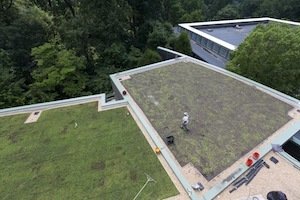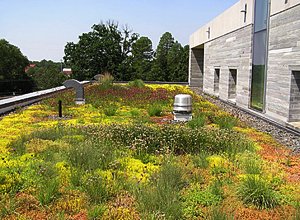Lang Performing Arts Center Roof Goes Green

This summer, the Lang Performing Arts Center (LPAC) got a new look in the form of a recently installed green roof. On campus, the LPAC joins David Kemp and Alice Paul Halls, as well as part of Papazian Hall, to feature a green roof - and, at 31,000 square feet, more than doubles the College's total green roof acreage.
Green roofs first arrived on campus with the 2002-03 Environmental Studies capstone seminar. That year, students chose green roofs to study for the course; at the same time, the Engineering Department asked the College whether it could build a shed behind Papazian Hall to hold its lumber. The architect hired to design the shed was interested in green roofs and didn't waste any time adding one to the shed. According to Professor of Engineering Carr Everbach, within a single day, the College's first green roof was installed by an outside company based in Philadelphia.
Students were hooked. That spring, they suggested that a green roof be added to the new residence hall being designed at the time - Alice Paul Hall, which opened in 2004 and is named for the pioneering women's rights activist and member of the Class of 1905. Recruitment, research, and a bit of experimentation became the driving forces behind the project. The College's Director of Grounds Jeff Jabco enlisted the help of Jorg Brüning, a green roof designer from Germany who happened to be on his way to a conference in Chicago at the time, to act as the College's green roof consultant.

Everbach was in touch with Northeast Solite Corporation, a company owned by John Roberts '39, that sold a lightweight aggregate pumice-like material. Although it had never been used on green roofs before, Everbach convinced Roberts to donate enough Solite to the College for Alice Paul's roof.
"We said 'yes' to Carr," Roberts says, "because we wanted to make a meaningful contribution to Swarthmore that would also provide a learning experience."
To save time, money, and workers, Jabco came up with a novel method of planting; instead of hand-planting each plant individually, they threw the plants in a blender, chopped them up, scattered them amongst the Solite, and spread the Solite-plant mixture across the roof. "It saved us hundreds of hours and dozens of people planting," Everbach says.
This home-grown collaboration and design was so successful, it was applied again on David Kemp Hall, which opened in 2009 and is named for the father of Gil Kemp '72. While an outside company was brought in to install the newest roof on LPAC, Solite was still used and Jabco's plant-chopping method was implemented again. Everbach is also helping to organize the construction of a green roof on Strath Haven Middle School in Wallingford, Pa., with Jabco helping to advise the project.
From an energy standpoint, one of the biggest impacts that green roofs have is their ability to keep the entire roof cool, helping to maintain a more desirable temperature difference between the roof and the room - between 10 and 15 degrees, according to Everbach. Green roofs may also appear expensive, due to the costs of materials and construction. However, they make up for their initial cost in the long run, by protecting the roof membrane from the sun.
"The sun is pounding down on a roof day in and day out for decades," Everbach says. "No matter if it's made out of rubber or plastic or tar, it starts to crack." Cracks that are prevented, he says, translate to one less roof replacement, which can save hundreds of thousands of dollars.
The biggest beneficiary of a green roof at Swarthmore? The Crum Creek, which runs adjacent to campus. All of the rain that currently falls on campus flows directly to the creek, causing it to flood. "The rain [used to] only fall on wooded land," Everbach explains, "and it would take a while for the water to percolate to the creek. Now the rain falls on roofs and parking lots and there are pipes that take it straight to the creek." However, with a green roof, "any water that falls is cleaned first by the plants. They use the pollutants as nutrients."
While the roof of LPAC still looks somewhat bare, Everbach promises that in six month's time, it will rival those already in full bloom.


